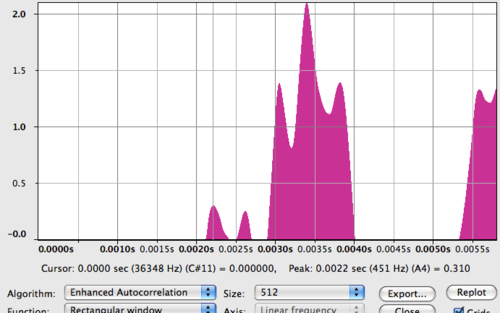Have you wished you could sing the songs you love – but thought it was impossible because you can’t sing in tune? Do your friends and family make a face when you sing in front of them? Maybe a school teacher once told you that you can’t sing or were singing “off key”. Or perhaps you just have a feeling that you have a bad singing voice…
Whatever the cause, something has made you think that you have problems singing and left you wondering:
“Why can’t I sing in tune?”
The good news is that you can learn to sing in tune – and it’s easier than you might think.
Many people have difficulty singing in tune at all, while others can start off okay but then can’t hold a tune or gradually start hitting wrong notes or wandering out of key. Although we would say that these people have a bad voice or are fundamentally a bad singer, this isn’t a permanent trait – it’s simply that they haven’t yet learned to sing in tune.
That’s probably the biggest problem with learning to sing: that we start out with the wrong idea, that singing is a natural talent you need to be born with. It really isn’t. Just ask George Bevan, director of the Choir Who Can’t Sing, who specialises in helping people who think they “can’t sing” discover that they actually can.
In reality even the best singers have practiced, trained and studied to refine their voices. Just because they make it look easy, it doesn’t mean that it was.
So rest assured, whatever your current singing ability, you can learn to sing in tune and develop a good voice.
In this article we’re going to cover four simple steps you can start taking today to learn to sing in tune.
These steps start from scratch and build up your singing ability in a logical way towards singing real songs reliably in tune. After taking these four steps you will understand clearly how to sing in tune. You may not be the next Pop Idol superstar but you will know for certain that you are always in tune and perfectly pitched each time you open your mouth to sing.
Excited to start? Let’s dive in!
 Step 1: Check you’re not tone deaf
Step 1: Check you’re not tone deaf
The first step in learning to sing in tune is to check that you are biologically capable of it. Often when we talk about someone who can’t sing you’ll hear the phrase “tone deaf”, as in:

“Hah, that guy can’t sing at all, he’s totally tone deaf.”
But what does that actually mean?
Tone deafness is a real condition. It is part of a biological condition of the brain called amusia which encompasses a number of musical inabilities, including some related to rhythm rather than pitch. As part of amusia, tone deafness means that you are incapable of hearing the differences between musical pitches.
In practice this means that if someone played two different notes on a piano, someone with true tone deafness would be unable to tell whether it was the same note or two different notes. Naturally, if that person tried to sing they would have real difficulty because their ears and brain wouldn’t have a clue if they were singing the right notes or not.
Does that sound like you?
If you’ve had trouble singing in the past you might have wondered if you suffer from tone deafness.
Here’s the thing you need to know though:
and there are other (much more likely) reasons
for singing out of tune.
Less than 3% of the general population actually exhibit tone deafness. This has been shown in a large number of tests and rigorous scientific studies, and so the probability of you being tone deaf is very small.
Fortunately there’s even a simple and fast way to check if you’re tone deaf. You can take an ear test online in just a few minutes and find out for certain whether tone deafness is responsible for your difficulty singing. Take one of these tone deafness tests and you’ll be one step closer to understanding what holds you back as a singer.
This isn’t a “hearing test”, it’s not checking for hearing damage or age-related hearing loss. And don’t worry about whether you have a “musical ear” or not. The tone deaf tests which are well-designed don’t require any musical knowledge or skill. They test only the basic biological ability of distinguishing different pitches. You can be totally unmusical and still pass the test, because tone deafness isn’t actually about musical skill, it’s much more fundamental than that.
Ready to find out? You can take the Tone Deaf Test which has already helped almost half a million people to discover whether or not they are actually tone deaf…
Then, assuming you pass the test, it’s time to continue on to the next step.
 Step 2: Learn to match pitch
Step 2: Learn to match pitch
 Now that you know your ears and brain are fundamentally capable of telling whether a note is in tune or not, it’s time to address the most likely cause of your difficulty singing in tune: an inability to match pitch with your voice.
Now that you know your ears and brain are fundamentally capable of telling whether a note is in tune or not, it’s time to address the most likely cause of your difficulty singing in tune: an inability to match pitch with your voice.
To “match pitch” simply means that you hear a note and then you are able to sing that same note. When people talk about hitting the right notes, this is what they mean.
If you’ve had trouble singing in tune or hitting the right notes when you sing, or somebody has made a comment about you having bad pitching or poor tuning, this is most likely the skill you need to focus on.
Note that we’re not yet getting anywhere near singing a song! Before you can step up onto that karaoke stage you need to make sure you can do this one simple thing: match pitch with your voice. After all, if you can’t sing one single note in tune, there’s not much hope that your belting rendition of Bruno Mars or Whitney Houston is going to wow the crowd, right?
So how can you learn to match pitch? The answer is that there are simple singing exercises you can do learn get reliable vocal control and learn to easily hit the target note first time, every time.
Learning this skill is about connecting up your ears (which we just proved are up to the task in step one) with your voice. There’s a sort of “feedback loop” that you need to practice, where you sing a note, hear whether that note is at the right target pitch or not, and then adjust accordingly.

Here are three ways you can learn to match pitch:
- Learn to match pitch with a digital tuner
- Learn to match pitch with an app
- Learn to match pitch by recording yourself
1. Learn to match pitch with a digital tuner
 This is a simple way to practice hitting the right note and singing with good pitching. If you have a digital tuner for your instrument (e.g. a guitar tuner) you can use that, otherwise you can use an online tuner like this one.
This is a simple way to practice hitting the right note and singing with good pitching. If you have a digital tuner for your instrument (e.g. a guitar tuner) you can use that, otherwise you can use an online tuner like this one.
The idea is that like tuning an instrument, you learn to tune your voice. Most digital tuners allow you to play the target note, but if not you’ll also want to have an instrument handy to play the note you’re aiming for. Then you simply use the digital tuner’s display to help develop your “feedback loop”. It provides a visual way to know whether you’re singing too high or too low.
- Set the tuner to your target note (e.g. A).
Choose a note in your comfortable singing range. - Listen to the tuner play the note.
It will probably be a very simple ongoing “tone” or electronic beep. Alternatively play the target note on your instrument. You might like to try humming along with the sound. - Hear the note in your head.
This skill of imagining music in your head is called “audiation” is powerful for singing: it connects hearing music with singing it. You hear, then you imagine hearing, then you sing. - Sing the note.
While you sing, watch the tuner to see if your pitch is too high or too low. Gradually adjust your pitch until you hit the target note.
The key to this exercise is to make sure you are listening carefully as you practice. Don’t just rely on the tuner’s display. Try to always hear whether you are too high or too low before checking the display. That way you are gradually developing your own inner tuner so that in future your feedback loop can work directly without the assistance of a digital tuner.
2. Learn to match pitch with an app
 Although the digital tuner exercise is simple and easily available to anyone, there is a better way. You can use a mobile app or web game to practice singing in tune.
Although the digital tuner exercise is simple and easily available to anyone, there is a better way. You can use a mobile app or web game to practice singing in tune.
We have an app called SingTrue for iPhone and iPad which is specially designed to help people learn to match pitch with their voice. It automatically chooses notes in your comfortable singing range and gives you a range of simple fun exercises to practice matching pitch. And instead of the momentary display of the digital tuner, you can actually see a graph of how your vocal pitch varied over time which gives you a clearer idea of how your pitch skills are developing.
You can download SingTrue for free in the iTunes App Store.
Another option is the excellent Vocal Match game from Theta Music which works in your web browser and lets you practice matching pitch with your voice.
3. Learn to match pitch by recording yourself
You can also check your pitch accuracy using free audio recording and analysis software such as Audacity. You can read a full tutorial on recording and analysing your singing pitch but the basic process is:
- Record yourself singing a simple melody.
- Use the software’s pitch analysis to view the actual pitch of your voice during the performance.
- Identify notes which you sang off-pitch and then try again and correct them.
Note: Your Vocal Range
This is a good time to talk about your vocal range. One of the biggest causes of singers singing out of tune is that they’re trying to sing outside their comfortable range.
Every singer has a range of notes their voice is physically capable of producing. There are advanced techniques and long-term training which can extend this, but as a beginner you want to make sure you stay comfortable in your “easy” range. As soon as you start stretching your voice too high or too low your pitching will suffer (and so will your listeners!)
There’s a simple trick you can use to determine your vocal range.
First, just speak a sentence: Say “I am learning to sing in tune”.
Listen as you speak, and when you say the last word “tune”, hold on it: “tuuuuuuuuuunne”.
That “ooooh” sound is a note, and you are singing it.
Our speaking voice is always inside our comfortable singing range, so you can treat this as an “anchor note” or a starting point for exploring your range. From this note, try sweeping up and down in pitch with your voice.
See how far you can go before your voice starts to feel strained. Put a pin in it (i.e. use an instrument to find out what note it was!) and keep that in mind as the limit of your range.
As you continue learning to sing in tune, make sure you stay in this range. You’ll save yourself a lot of pain and frustration!
Once you know your approximate range and you’ve got the hang of matching pitch quickly with your singing voice you’re ready to move on to step three.
 Step 3: Develop vocal control
Step 3: Develop vocal control
We’re going to continue building up your singing ability with the next logical step: from a single note sung in tune, to singing multiple notes in tune.
The next step is to learn to control your voice as you move from note to note. This is what allows you to sing a whole song and stay in tune with accurate pitch throughout. Without this skill you might sing your first note correctly but then hit the wrong note next or gradually go off key. If you’ve ever seen a karaoke performance which starts off strong but sounds worse and worse as the song goes on, this is probably the step which that singer skipped in their training!
The big challenge for most new singers is handling leaps in pitch. Moving between notes which are close together is relatively easy, but when there’s a leap (e.g. think of the first two notes of “Somewhere over the rainbow”, “Some – where”) it can become quite hard to accurately hit that second note dead-on.
So how do you learn the vocal control required to move comfortably and accurately from note to note? There are two tools you can use.
1. Use scales and exercises to learn vocal control
Even if you’ve never studied music you’re probably familiar with the concept of a “scale”, where a singer sings a series of notes going up in a row and then back down. There are different types of scale and they’re popular as a warmup exercise because they are a gentle way to move your voice across a range of pitches while requiring accurate pitching on each one.
Here’s an example of a scale:
You can practice singing scales like this as part of developing vocal control. Remember to choose scales which lie in your comfortable range. If that means you can only sing part of the scale, that’s fine. Remember you are just using this as a way of practising your vocal control.
Once you can easily sing scales you can move on to leaps in pitch (also known as singing intervals).
→ See more exercises for vocal control and pitch practice
2. Use solfa to practice singing in tune
 A very useful framework for practising vocal control is solfa (a.k.a. “solfege” or “do re mi”). This is a system where you give a name to each note in the scale, which makes it easier to understand which note you’re aiming for each time you change pitch.
A very useful framework for practising vocal control is solfa (a.k.a. “solfege” or “do re mi”). This is a system where you give a name to each note in the scale, which makes it easier to understand which note you’re aiming for each time you change pitch.
You can do similar scale and pitch leap exercises using the solfa framework, and it also provides intuitive ways to play around with vocal improvisation which makes the whole process a bit more fun.
We have a free series to help you learn about singing with solfa.
Another important note about solfa is that it’s the key to sight-singing music easily. This means that you can confidently go along to a choir or other singing group and know that if they hand you sheet music you don’t need to panic! You can use solfa to know what notes to sing and your newfound vocal control to know you’ll be singing them right.
 Step 4: Prove you can sing in tune
Step 4: Prove you can sing in tune
The final step in the process is to start singing real songs, and to do it in a way which actually proves to you that you are singing in tune.
Confidence is vital for good singing, and the shortest way to get confident about your singing is to see proof that you sing in tune. That way you can step up on stage or join a choir safe in the knowledge that your voice will be in tune and you’ll sound good when you sing.
→ Learn more about musical confidence
There is a simple secret weapon to learning to sing songs and stay in tune: recording yourself.
Record yourself singing
This can be intimidating and unnerving at first – but it’s still less scary than singing in front of other people, right? You can be alone in your room to do it, and the only person who’ll ever hear the recordings is you. So there’s nothing to be embarrassed about.
Recording yourself singing is hard at first because you won’t like the sound of your own voice. There is a solid reason for this:
This happens because your voice actually sounds different to you than other people. This is due to the physics of sound being carried inside your body as well as outside through the air when you hear it. When you hear a recording you are actually hearing what other people hear when you sing.
You’ll need to summon a bit of grit to work through those first few awkward days of recording yourself. Almost everybody hates the sound of their voice when they first hear it on a recording. You need to remember that this is most just the discomfort of unfamiliarity – it’s not that your voice or singing is bad.

After you get used to it you’ll start to be able to hear how good your voice truly is, and this is where recording yourself becomes a powerful secret weapon. You can hear where your pitching is off and then correct it next time. You can hear when your enunciation isn’t quite right and then improve it. You can start to form an objective opinion about how good a singer you are.
Recording yourself gives you the opportunity to perfect your performances in private before ever sharing them with the outside world.
Build up your repertoire
So what exactly should you record yourself singing? The answer is: your repertoire. That’s a fancy term musicians use to mean “the stuff they know and perform”. As a singer it just means a collection of songs you’re confident singing.
Begin by aiming for just a 3 song repertoire. Pick three songs you like and which are in your comfortable range. It helps to memorise the song lyrics so that you have one less thing to think about as you sing.
 Start by practicing with a backing track. You can normally find karaoke versions of popular songs on YouTube, or if necessary you can use the regular studio version, singing along with the lead singer. Begin with just a short section of the song, for example just the chorus.
Start by practicing with a backing track. You can normally find karaoke versions of popular songs on YouTube, or if necessary you can use the regular studio version, singing along with the lead singer. Begin with just a short section of the song, for example just the chorus.
Record your performance, then summon some courage and listen back.
Without a doubt, you’ll find parts you weren’t happy with. Don’t criticise yourself for this! Every negative thing you notice is an opportunity to improve. Like when you found out you weren’t tone deaf, this just shows that you have the awareness you need to be able to improve. Exciting!
So try it again. And again. You might find it helps to jot down notes on a copy of the lyrics to remind yourself of your advice and the areas for improvement.
Here’s an extra tip: don’t throw the recordings away! Save each one, putting the song name and today’s date in the filename. Then, after a few days of practicing a song, come back and listen to one of your earlier performances. You’ll most likely be able to hear a big improvement and that will encourage you to keep at it.
Eventually you’ll feel you’ve got the hang of the song. You can no longer spot pitching issues or performance weaknesses. Hurrah!
You’ve got one song for your repertoire. Time to add another one.
 You’re Ready. Sing in Tune!
You’re Ready. Sing in Tune!
So you were worried about singing off key and out of tune. After reading through these four steps you should have a clear understanding of the simple process you can use to learn to sing in tune.
- You’ve discovered that you’re not in fact tone deaf and never need to wonder about that again.
- You’ve learned about matching pitch with your voice and how that’s the key skill needed to sing in tune.
- You understand how to build that skill to multiple notes by using scales and exercises (possibly solfa) to develop good vocal control.
- And you have a secret weapon you can use to practice songs until you perfect them.
As you work through these steps remember that learning to sing in tune is simple and methodical process. You might hit some snags along the way (because learning is like that) but as long as you follow this process and don’t try to run before you can walk, you should find it is a smooth and enjoyable journey.
By the end of these four steps you will have built up a small repertoire of songs you can sing well. You can be totally confident stepping up on that karaoke stage or singing with friends because you have proven to yourself very clearly that you do sing in tune and you can sing these songs well. Once you get past the scary barrier of wondering whether you’re in tune, singing is one of the most absolutely wonderful ways to express yourself musically. So have fun!


 Step 2: Learn to match pitch
Step 2: Learn to match pitch

 Step 3: Develop vocal control
Step 3: Develop vocal control Step 4: Prove you can sing in tune
Step 4: Prove you can sing in tune You’re Ready. Sing in Tune!
You’re Ready. Sing in Tune!




